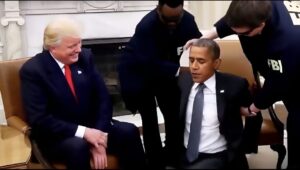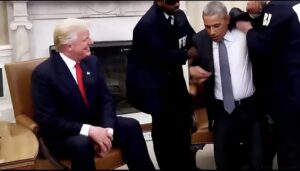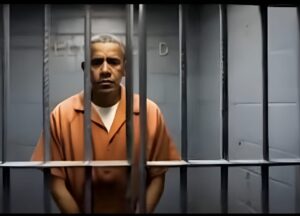On Monday, former U.S. President Donald Trump intensified his criticism of Barack Obama by sharing an AI-generated video depicting FBI agents arresting Obama in the Oval Office.
On Monday, former U.S. President Donald Trump escalated his ongoing attacks on Barack Obama by sharing an AI-generated video that depicts the former president being arrested by the FBI in the Oval Office. The video, posted on Donald Trump’s social media platform Truth Social, has drawn widespread backlash for its misleading content and lack of disclaimers.
The controversial video opens with a fabricated clip of Obama saying, “Especially the President is above the law,” followed by various real-life clips of American politicians repeating the phrase, “No one is above the law.” It then transitions into an AI-generated scene of Obama being handcuffed by two FBI agents in the very office he once occupied. Donald Trump is also digitally inserted into the video, shown sitting and smiling as the arrest unfolds before him.

The video ends with an AI-generated image of Obama behind bars, wearing an orange prison jumpsuit typically associated with federal inmates. Donald Trump did not include any indication that the video was fictional or AI-generated, a decision that critics and political analysts have condemned as “deeply irresponsible.”
“This is dangerous territory,” said one political commentator. “Sharing fake visuals of a former president being arrested without context or clarification not only misleads the public but adds fuel to an already divided political climate.”
The release of the video comes on the heels of renewed allegations from Donald Trump and his allies, who have accused Obama of orchestrating a “high-level election fraud” effort. The former president has intensified his rhetoric in recent weeks, alleging that top officials from the Obama administration attempted to sabotage his 2016 victory and subsequent presidency.
Adding further fuel to the controversy, former Democratic congresswoman and current U.S. Director of National Intelligence Tulsi Gabbard made headlines last week when she claimed to have “striking” and “overwhelming” evidence that former Obama administration officials had fabricated the Trump-Russia collusion narrative. According to Gabbard, this was done after Trump’s 2016 win to delegitimize his presidency and “undermine American democracy.”
“Americans will finally learn the truth about how, in 2016, intelligence was politicized and weaponized by the most powerful people in the Obama administration,” Gabbard wrote in a detailed post on (formerly Twitter). She further claimed this was part of a coordinated effort to launch what she described as a “years-long coup against President Donald Trump.”
However, Gabbard’s explosive claims have been met with skepticism. The Office of the Director of National Intelligence (ODNI) recently released a 114-page report that offers a contrasting narrative. According to the ODNI, the U.S. Intelligence Community consistently assessed prior to the 2016 election that Russia was “probably not trying to influence the election by using cyber means.”
The report also noted that a draft of the President’s Daily Brief dated December 8, 2016, explicitly stated that Russia “did not impact recent U.S. election results” through malicious cyber activity targeting election infrastructure.
This latest controversy comes as AI-generated did by Donald Trump.

This latest controversy comes as AI-generated content becomes increasingly difficult to distinguish from reality, raising serious ethical and political questions. Critics warn that the use of such manipulated media by prominent political figures, especially without proper labeling, could lead to mass misinformation, erode public trust, and inflame existing political divides.
While Trump’s post has energized his base, others are calling for greater accountability from public figures who share AI-generated media. Legal experts and political ethicists alike are now discussing whether such actions, if proven to incite false narratives or unrest, could have broader consequences.
With the 2024 presidential election on the horizon, the spread of synthetic content — especially from political leaders — is likely to become a focal point in debates around media integrity, disinformation, and digital ethics.

